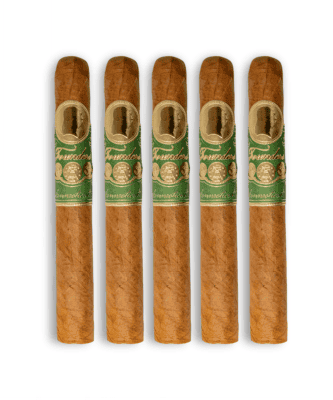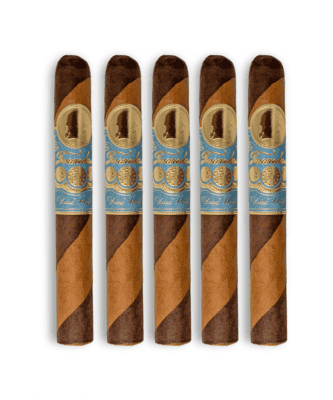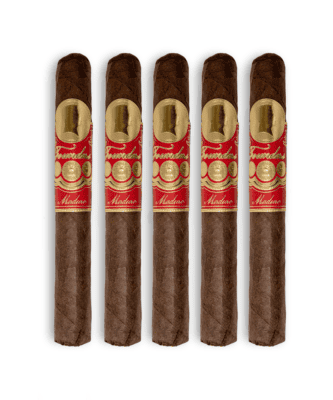Cigar enthusiasts know that a cigar’s wrapper is essential to its overall flavor, aroma, and appearance. In this comprehensive guide, we delve into the world of cigar wrappers, exploring their origins, types, and characteristics to help you better appreciate these exquisite works of art.
A Brief Introduction to Cigar Wrappers
The cigar wrapper is the outermost leaf that encases the filler and binder, imparting its unique qualities to the overall smoking experience. A good cigar wrapper is visually appealing and contributes significantly to the cigar’s flavor, burn, and construction.
The Importance of the Wrapper in a Cigar’s Flavor Profile
Although the wrapper accounts for only a small percentage of a cigar’s total tobacco content, it significantly determines its flavor profile. Wrappers can contribute anywhere from 30% to 60% of a cigar’s flavor, depending on the type and thickness of the leaf. A well-chosen wrapper can enhance the complexities of the cigar’s blend, creating a harmonious and satisfying smoking experience.
The Different Types of Cigar Wrappers
There are numerous types of cigar wrappers, each with its distinct characteristics. Some of the most popular wrapper types include:
1. Connecticut Shade
Connecticut Shade wrappers are grown under shade cloth in the Connecticut River Valley of the United States. These wrappers are prized for their light, golden color, and delicate, smooth texture. In addition, they impart a creamy, mild flavor with hints of grass, cedar, and toast.
2. Connecticut Broadleaf
This sun-grown wrapper, also hailing from the Connecticut River Valley, is known for its dark, oily appearance and rugged texture. Connecticut Broadleaf wrappers provide a rich, earthy flavor with chocolate, coffee, and leather notes.
3. Habano
Habano wrappers originated from Cuba and are now primarily grown in Nicaragua and Ecuador. These wrappers have a reddish-brown color and a slightly oily sheen. They are characterized by their spicy, peppery flavor, often accompanied by a hint of sweetness.
4. Maduro
Maduro, which means “ripe” in Spanish, refers to extended fermentation that produces a dark, oily wrapper. Maduro wrappers can be sourced from various tobacco types, including Connecticut Broadleaf, Habano, and San Andrés. These wrappers offer a rich, sweet flavor with chocolate, coffee, and dark fruit notes.
5. Oscuro
Oscuro wrappers are the darkest and most robust of all wrapper types. They undergo an even longer fermentation process than Maduro wrappers, resulting in a nearly black color and a thick, oily texture. As a result, Oscuro wrappers provide bold, full-bodied flavors with pronounced earthiness and hints of espresso, leather, and dark chocolate.
6. Candela
Candela wrappers, also known as “double claro” or “American Market Selection,” are characterized by their green hue, achieved through a rapid drying process that locks in the leaf’s chlorophyll. These wrappers impart a light, grassy flavor with a touch of sweetness.
Factors Influencing Wrapper Characteristics
Several factors influence the characteristics of a cigar wrapper, including:
1. Soil and Climate
The soil composition and climate of the region where the tobacco is grown play a critical role in determining the wrapper’s flavor, color, and texture. For example, Nicaragua’s rich, volcanic soil imparts a distinct spiciness to its Habano wrappers. At the same time, the sandy loam of the Connecticut River Valley contributes to the smooth, mild flavor of Connecticut Shade wrappers. Soil nutrients, rainfall, and temperature fluctuations all contribute to the unique characteristics of each wrapper type.
2. Cultivation Methods
How tobacco is cultivated can significantly impact the wrapper’s quality and appearance. For instance, shade-grown wrappers like Connecticut Shade are grown under large tents made of cheesecloth, filtering sunlight and producing a lighter, more delicate leaf. In contrast, sun-grown wrappers develop a thicker, darker leaf with more pronounced flavors due to direct sunlight exposure.
3. Fermentation and Aging
Fermentation and aging can dramatically transform a cigar wrapper’s flavor, color, and texture. Fermentation involves stacking tobacco leaves in large piles called “piles,” where heat and humidity cause the leaves to break down and release their natural sugars. Depending on the desired result, this process can last anywhere from a few months to several years. Aging the fermented tobacco in controlled conditions further refines its flavors, producing a smoother, more nuanced smoking experience.
4. Rolling Techniques
The skill of the cigar roller, or “torcedor,” is essential in ensuring a well-constructed cigar that burns evenly and delivers a consistent flavor profile. A well-rolled cigar will showcase the wrapper’s characteristics to their fullest potential, while a poorly rolled cigar may lead to uneven burn, draw issues, or an imbalanced flavor experience.
How to Choose the Right Cigar Wrapper for Your Palate
Selecting a cigar with a wrapper that suits your taste preferences is crucial to enjoying the smoking experience. Consider the following tips when choosing a cigar based on its wrapper:
By understanding the intricacies of cigar tobacco wrappers and their impact on the smoking experience, you can confidently choose cigars that align with your taste preferences and enhance your appreciation for these carefully crafted works of art.




